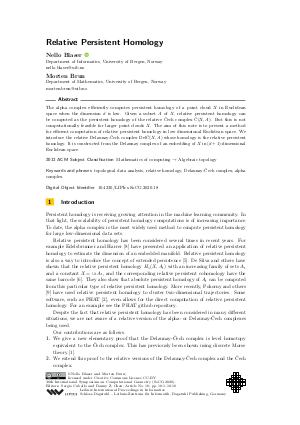Relative Persistent Homology
Authors
Nello Blaser  ,
Morten Brun
,
Morten Brun
-
Part of:
Volume:
36th International Symposium on Computational Geometry (SoCG 2020)
Part of: Series: Leibniz International Proceedings in Informatics (LIPIcs)
Part of: Conference: Symposium on Computational Geometry (SoCG) - License:
 Creative Commons Attribution 3.0 Unported license
Creative Commons Attribution 3.0 Unported license
- Publication Date: 2020-06-08
File

PDF
LIPIcs.SoCG.2020.18.pdf
- Filesize: 389 kB
- 10 pages
Document Identifiers
Subject Classification
ACM Subject Classification
- Mathematics of computing → Algebraic topology
Keywords
- topological data analysis
- relative homology
- Delaunay-Čech complex
- alpha complex
Metrics
- Access Statistics
-
Total Accesses (updated on a weekly basis)
0Document
0Metadata
Abstract
The alpha complex efficiently computes persistent homology of a point cloud X in Euclidean space when the dimension d is low. Given a subset A of X, relative persistent homology can be computed as the persistent homology of the relative Čech complex Č(X, A). But this is not computationally feasible for larger point clouds X. The aim of this note is to present a method for efficient computation of relative persistent homology in low dimensional Euclidean space. We introduce the relative Delaunay-Čech complex DelČ(X, A) whose homology is the relative persistent homology. It is constructed from the Delaunay complex of an embedding of X in (d+1)-dimensional Euclidean space.
Cite As Get BibTex
Nello Blaser and Morten Brun. Relative Persistent Homology. In 36th International Symposium on Computational Geometry (SoCG 2020). Leibniz International Proceedings in Informatics (LIPIcs), Volume 164, pp. 18:1-18:10, Schloss Dagstuhl – Leibniz-Zentrum für Informatik (2020)
https://doi.org/10.4230/LIPIcs.SoCG.2020.18
BibTex
@InProceedings{blaser_et_al:LIPIcs.SoCG.2020.18,
author = {Blaser, Nello and Brun, Morten},
title = {{Relative Persistent Homology}},
booktitle = {36th International Symposium on Computational Geometry (SoCG 2020)},
pages = {18:1--18:10},
series = {Leibniz International Proceedings in Informatics (LIPIcs)},
ISBN = {978-3-95977-143-6},
ISSN = {1868-8969},
year = {2020},
volume = {164},
editor = {Cabello, Sergio and Chen, Danny Z.},
publisher = {Schloss Dagstuhl -- Leibniz-Zentrum f{\"u}r Informatik},
address = {Dagstuhl, Germany},
URL = {https://drops.dagstuhl.de/entities/document/10.4230/LIPIcs.SoCG.2020.18},
URN = {urn:nbn:de:0030-drops-121762},
doi = {10.4230/LIPIcs.SoCG.2020.18},
annote = {Keywords: topological data analysis, relative homology, Delaunay-\v{C}ech complex, alpha complex}
}
Author Details
References
- Ulrich Bauer and Herbert Edelsbrunner. The Morse theory of Čech and Delaunay complexes. Trans. Amer. Math. Soc., 369(5):3741-3762, 2017. URL: https://doi.org/10.1090/tran/6991.
- Ulrich Bauer, Michael Kerber, Jan Reininghaus, and Hubert Wagner. Phat – persistent homology algorithms toolbox. Journal of Symbolic Computation, 78:76-90, 2017. Algorithms and Software for Computational Topology. URL: https://doi.org/10.1016/j.jsc.2016.03.008.
- Nello Blaser and Morten Brun. Sparse filtered nerves, 2018. ArXiv 1810.02149. URL: http://arxiv.org/abs/1810.02149.
- A. Borel and J.-P. Serre. Corners and arithmetic groups. Comment. Math. Helv., 48:436-491, 1973. URL: https://doi.org/10.1007/BF02566134.
- David Cohen-Steiner, Herbert Edelsbrunner, and John Harer. Extending persistence using Poincaré and Lefschetz duality. Foundations of Computational Mathematics, 9(1):79-103, February 2009. URL: https://doi.org/10.1007/s10208-008-9027-z.
- Vin de Silva, Dmitriy Morozov, and Mikael Vejdemo-Johansson. Dualities in persistent (co)homology. Inverse Problems, 27(12):124003, November 2011. URL: https://doi.org/10.1088/0266-5611/27/12/124003.
- Albrecht Dold. Lectures on algebraic topology. Classics in Mathematics. Springer-Verlag, Berlin, 1995. Reprint of the 1972 edition. URL: https://doi.org/10.1007/978-3-642-67821-9.
- Herbert Edelsbrunner and John Harer. Persistent homology - a survey. In Surveys on discrete and computational geometry, volume 453 of Contemp. Math., pages 257-282. Amer. Math. Soc., Providence, RI, 2008. URL: https://doi.org/10.1090/conm/453/08802.
- F. T. Pokorny, K. Goldberg, and D. Kragic. Topological trajectory clustering with relative persistent homology. In 2016 IEEE International Conference on Robotics and Automation (ICRA), pages 16-23, May 2016. URL: https://doi.org/10.1109/ICRA.2016.7487092.
- Raimund Seidel. The upper bound theorem for polytopes: an easy proof of its asymptotic version. Computational Geometry, 5(2):115-116, 1995. URL: https://doi.org/10.1016/0925-7721(95)00013-Y.
- Žiga Virk. Rips complexes as nerves and a functorial Dowker-nerve diagram, 2019. ArXiv 1906.04028. URL: http://arxiv.org/abs/1906.04028.
